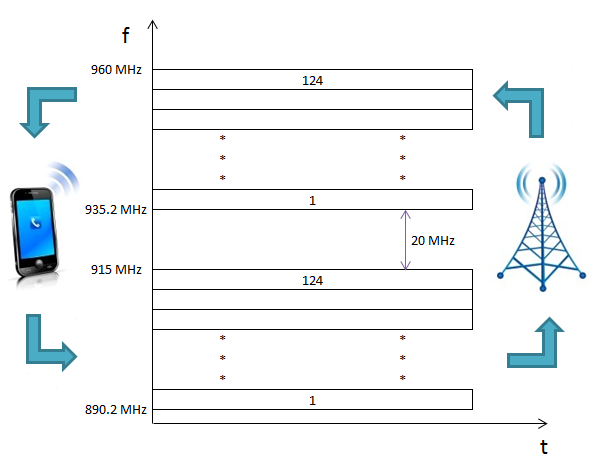SDMA, FDMA & TDMA
SDMA
This is one of the techniques that can be used for controlling the medium access for wireless networks. A mobile phone may receive signals from several base stations of different quality. A MAC algorithm could now decide which base station is best by considering the frequencies (FDM), time slots (TDM), or code (CDM).
SDMA is never used in isolation i.e. it uses a combination of one or more other schemes such as TDM, FDM and CDM etc.
FDMA
This technique comprises of algorithms that allocate frequencies to transmission channels according to FDM. This allocation can either be fixed e.g. Radio and dynamic channels can be given the same frequency at all the times (pure FDMA) or changed frequencies according to a certain pattern (FDMA combined with TDMA). For wireless systems, we use the second technique.
This technique can restrict interference of certain frequencies known as frequency hopping. In such a case, both the sender and receiver should agree upon a certain hopping pattern. Usually this hopping pattern is fixed for a longer period.
FDMA is commonly used for simultaneous access to the medium by the base station and mobile station in a cellular network. Here both the sender and the receiver should establish a duplex channel for simultaneous transmission in both directions before communicating. The lines from mobile station and base station and vice verse use separate frequencies. This scheme is sometimes called FDD (frequency division duplex).
In such a case both the sender and the receiver would know at what frequencies they can either send or receive, well in advance. The line that carries signals from mobile station to base station are called UP links, and the lines that carry the signals in the reverse direction are called down links.
Consider the following situation in a mobile phone network i.e. based on GSM standard operating at 900 MHz.
All up links use the frequency bands between 890.2 and 915 MHz. While all downlinks are 935.2 to 960 MHz.
Each channel (uplink and downlink) has a bandwidth of 200 KHz or 20 MHz.
Consider the following diagram

TDMA
TDMA is a much more flexible scheme than FDMA. This scheme requires only one frequency band and hence requires simple receiver and transmitters. Also, there is a number of algorithms control access to the medium.
Here, a station before transmitting can listen to different channels of same frequency but at different time intervals.
There are a number of types of TDM techniques such as:
1. Fixed TDM.
2. Classical Aloha.
3. Slotted Aloha.
4. CSMA.
5. Demand Assigned Multiple Access (DAMA)
6. Packet Reservation Multiple Access (PRMA)
7. Reservation TDMA
8. Multiple Access with Collision Avoidance (MACA)
9. Pulling
10. Inhibit Sense Multiple Access (ISMP)
Average Acceleration Calculator
Average acceleration is the object's change in speed for a specific given time period. ...
When an object falls into the ground due to planet's own gravitational force is known a...
In Mathematics, the permutation can be explained as the arrangement of objects in a particular order. It is an ordered...
A rectangle can be explained as a 4-sided quadrilateral which contains equal opposite sides. In a rectangle
A three sided polygon which has three vertices and three angles is called a triangle. Equilateral triangle...






